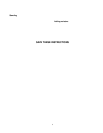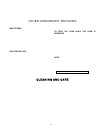·Plastic — Use only if labeled “Microwave Safe”. Other plastics can melt.
·Straw, wicker, and wood — Use only for short-term heating, such as warming dinner
rolls for a few seconds; baskets and bowls may be flammable.
Not Recommended
·Glass jars and bottles — Regular glass is too thin to be used in a microwave. It can
shatter and cause damage and injury.
·Paper bags — These are a fire hazard, except for popcorn bags that are designed for
microwave use.
·Styrofoam plates and cups — These can melt and leave an unhealthy residue on food.
·Plastic storage and food containers — Containers such as margarine tubs can melt in
the microwave.
·Metal utensils — These can damage your oven. Remove all metal before cooking.
Note: Should you wish to check if a dish is safe for microwaving, place the empty dish in the oven and
microwave on HIGH for 30 seconds. A dish which becomes very hot should not be used.
COOKING TECHNIQUES
Your microwave makes cooking easier than conventional cooking, provided you keep these considerations in
mind:
Stirring
Stir foods such as casseroles and
vegetables while cooking to distribute heat
evenly. Food at the outside of the dish
absorbs more energy and heats more
quickly, so stir from the outside to the
center. The oven will turn off when you
open the door to stir your food.
Arrangement
Arrange unevenly shaped foods, such as
chicken pieces or chops, with the thicker,
meatier parts toward the outside of the
turntable where they receive more
microwave energy. To prevent overcooking,
place delicate areas, such as asparagus
tips, toward the center of the turntable.
Shielding
Shield food with narrow strips of aluminum
foil to prevent overcooking. Areas that
need shielding include poultry wing-tips,
the ends of poultry legs, and corners of
square baking dishes. Use only small
amounts of aluminum foil. Larger amounts
can damage your oven.
Turning
Turn foods over midway through cooking to
7


















